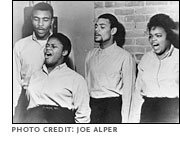|
Awakenings (1954-1956) Lesson 1: Injustice anywhere is a threat to justice everywhere.
|

Alper, Joe. Student Protestors. Digital image. American Experience: Eyes on the Prize. PBS. Web. 24 Jan. 2010.
|
 Alper, Joe. Student Protestors. Digital image. American Experience: Eyes on the Prize. PBS. Web. 24 Jan. 2010. |
Links: |
Throughout the first half of the twentieth century, American society was sharply segregated along color lines. Supported by both law and custom, the Jim Crow system—late nineteenth-century rules and regulations that codified a long tradition of prejudice, dehumanization, and discrimination—created separate and unequal services, employment, and housing for blacks and whites. After watching the first episode, you have seen the events that brought this discrimination and violence to public awareness and the awakening of the growing civil rights movement. Time line of events. 1954 May 17 In Brown v. Board of Education, the Supreme Court declares that segregated schools are inherently unequal and thus unconstitutional. 1955 Aug. 28 Emmett Till, a black boy from Chicago visiting his uncle Moses Wright in Mississippi, is murdered for inappropriately addressing a white woman. Sep. 23 Two white men are tried in the murder of Emmett Till but are quickly acquitted. Dec. 1 Rosa Parks is arrested in Montgomery, AL for refusing to relinquish her seat in the front of the bus to a white person. Dec. 5 King leads the blacks of Montgomery in a rally to boycott city buses. In response to the blacks’ bus boycott, many whites join White Citizens’ Councils to uphold segregation and white control of the region. 1956 Nov. 13 The Supreme Court rules that segregation on buses in Montgomery is against the law. Dec. 21 The Supreme Court rules that segregation on Montgomery buses is illegal and the boycott ends. The Assignment: Read the New York Times editorials from April 26, 1956 and June 4, 1961. In paragraph form, tell what message they have in common. If you had been alive during the Civil Rights Movement, tell if you would have agreed or disagreed with the idea that non-southerners should show restraint in their demands regarding civil rights in the South because the issue was none of their business. Next, imagine that you just read one of the editorials in the morning paper, and write a letter to the editor in response to it, expressing your support or disapproval. In your letter, identify your race and whether you live in the South if you think those facts are relevant to your argument. |